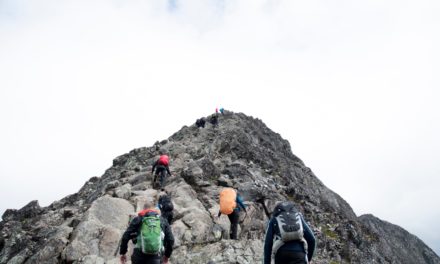Author Max de Pree has said that the first task of leadership is to define reality. For any forward-thinking leader today, there is a sharp appreciation for the changed reality that they now face.
There has long been talk of a ‘volatile, uncertain, complex and ambiguous world’ – or what we term a ‘VUCA’ world. Pre-pandemic we spoke a great deal about this ‘VUCA’ world, but our actions betrayed a quiet contentment with what we had and how we went about things, none more so than when it came to leadership thinking and practice.
 The pandemic changed all that and for many, the new appreciation of our VUCA reality has been a painful lesson to absorb. Warren Buffett once said (albeit in relation to financial markets yet applicable to this context) that, “only when the tide goes out do you discover who has been swimming naked”. Well, the tide went out quite suddenly!
The pandemic changed all that and for many, the new appreciation of our VUCA reality has been a painful lesson to absorb. Warren Buffett once said (albeit in relation to financial markets yet applicable to this context) that, “only when the tide goes out do you discover who has been swimming naked”. Well, the tide went out quite suddenly!
Leadership is not what it once was and nor will it ever be that again. The context for leadership has changed. If you find yourself in leadership, it is a contextual shift that requires your full attention!
We don’t need leadership in the spaces where challenges are known, understood and routined…where we have experience and know-how. We now need leadership to overcome the unknown, non-routined, complex problems; the ones where people need to be involved and mobilized towards a solution that at present, still awaits discovery.
Leaders need to ‘know what to do when they don’t know what to do’ – or what, in the language of Ron Heifetz’s Adaptive Leadership model, is known as an ‘adaptive challenge’.
In the face of adaptive challenges, the place where you don’t know what to do, leaders need to know what to do. Knowing what to do requires adaptive intelligence – something that will increasingly become the currency of effective leadership; adaptive intelligence enables the leader (and the collective) to recognise, engage and ultimately thrive in the midst of our VUCA world. It is the preeminent work demanded of any leader whose intent it is to be future-fit.
But what exactly is ‘adaptive intelligence’ and how does one develop it? Research done by Gunderson and Holling in 2002 (on coral reefs in the Pacific) provides four helpful pointers – albeit from an unusual source – for those leaders wishing to develop adaptive intelligence. They found that the following four characteristics are essential to building adaptive capacity – or what I have tagged, ‘the ‘DNA’ of adaptive intelligence. Their research provides us with a practical framework from which to understand and develop this adaptive capacity.
The four characteristics of Adaptive Intelligence are:
- Embracing change and uncertainty.As we have see
 n, this is no longer an option for those in leadership. Peter Drucker warned that in the face of turbulence the biggest danger is not the turbulence but rather the use of yesterday’s logic in the turbulence. Some are better equipped than others to cope with the uncertainty and ambiguity that prevails. Leaders need to understand their own disposition towards these features of our reality and plot their way from there.As a leader, if you are not comfortable around change and uncertainty, how can you expect those around you – or your organization, to thrive in the certainty of uncertainty? Adaptive leaders don’t merely accept change and uncertainty, they learn to embrace it!
n, this is no longer an option for those in leadership. Peter Drucker warned that in the face of turbulence the biggest danger is not the turbulence but rather the use of yesterday’s logic in the turbulence. Some are better equipped than others to cope with the uncertainty and ambiguity that prevails. Leaders need to understand their own disposition towards these features of our reality and plot their way from there.As a leader, if you are not comfortable around change and uncertainty, how can you expect those around you – or your organization, to thrive in the certainty of uncertainty? Adaptive leaders don’t merely accept change and uncertainty, they learn to embrace it! - Activating difference.Diversity at multiple levels – be that cultural, gender, ethnic, structural, generational or personal (to name but some of the ‘categories’) – is what infuses the daily reality and terrain of contemporary leadership.We have come to appreciate that having a diverse team or group does not, on its own, unlock the many benefits offered by such diversity; something more is required. That ‘something’ is what we have labeled ‘inclusion’- having a truly inclusive environment or culture – one where everyone feels they can contribute, where they are seen, heard, and appreciated.Creating such a place, when there is a wide swath of diversity present, is easier said than done. Many in leadership find themselves ill-equipped to deal with the challenges posed. Identifying and confronting their own biases and prejudices, doing the necessary inner-work of leadership, and understanding the importance of emotional intelligence are all part of this journey.In my experience across multiple formal leadership development programmes, I have found that this is spoken about a great deal more than it is done. We know that we ‘need to do it’ but stop short of actually doing the required work.The capstone for activating difference is the recognition that there is a ‘best in everyone;’ that everyone has a valid contribution to make, and they would rather make that contribution than not (make it). With those key assumptions embedded, a leader can then learn what it takes to create the kind of environment that invites the best out of others.
- Being a learner.In many instances senior leaders are no longer learning. They are backing their years of experience – what they have already learnt, to get them through whatever lies ahead. When leaders stop learning it proves fatal.
 Learning is essential in what it takes to be adaptive. Learning is required in identifying the adaptive challenge – understanding why things are no longer working as they once did or expected; and new learning is a prerequisite in finding the solution as in the face of an adaptive challenge, nothing from the past is helpful.In fact, a sure why to know that you are encountering an adaptive challenge is when you hear this kind of comment around the table: “But weren’t we having this same conversation eight months ago?” Through the rigid and somewhat unimaginative methodology often embraced by most business schools and those entrusted with our corporate learning – there is much exploration to be done in this area. Such exploration invites fresh and deeper discovery when it comes to learning, unlearning and relearning what we need to in order to confidently engage the future.The willingness to endure discomfort and disequilibrium; to be willing to try new things and to risk failure and the boldness to challenge existing ‘successful’ models of leadership education, will all form part of the necessary terrain that marks this point in growing adaptive intelligence.Alvin Toffler, a futurist, once said: “The illiterate of the 21st Century will not be those who cannot read and write but those who cannot learn, unlearn and relearn”. Social philosopher Eric Hoffer said that “in times of change, learners inherit the earth, while the learned find themselves beautifully equipped to deal with a world that no longer exists”. He was right…they both are!
Learning is essential in what it takes to be adaptive. Learning is required in identifying the adaptive challenge – understanding why things are no longer working as they once did or expected; and new learning is a prerequisite in finding the solution as in the face of an adaptive challenge, nothing from the past is helpful.In fact, a sure why to know that you are encountering an adaptive challenge is when you hear this kind of comment around the table: “But weren’t we having this same conversation eight months ago?” Through the rigid and somewhat unimaginative methodology often embraced by most business schools and those entrusted with our corporate learning – there is much exploration to be done in this area. Such exploration invites fresh and deeper discovery when it comes to learning, unlearning and relearning what we need to in order to confidently engage the future.The willingness to endure discomfort and disequilibrium; to be willing to try new things and to risk failure and the boldness to challenge existing ‘successful’ models of leadership education, will all form part of the necessary terrain that marks this point in growing adaptive intelligence.Alvin Toffler, a futurist, once said: “The illiterate of the 21st Century will not be those who cannot read and write but those who cannot learn, unlearn and relearn”. Social philosopher Eric Hoffer said that “in times of change, learners inherit the earth, while the learned find themselves beautifully equipped to deal with a world that no longer exists”. He was right…they both are! - Giving control.This final point warrants deeper thought, discussion and mention than is possible here. It invites deeper interrogation within your own context. Unexpected disruption and unpredictability necessitate agility and adaptability – which can only be achieved by loosening control.What this means and what this looks like would be worthy discussion for any executive team agenda. Semler, in his account of his leadership journey at Semco (https://www.amazon.com/Seven-Day-Weekend-Changing-Work-Works/dp/1591840260) provides some interesting insights into what becomes of a willingness to trust the process of self-organization. Of course, there are more recent examples of ‘giving control’ one such example being the remarkable story of US nuclear submarine commander David Marquet. Marquet’s very readable book, Turn the Ship Around https://www.amazon.com/Turn-Ship-Around-Turning-Followers/dp/1591846404, documents how he gave away command on his submarine in order to achieve better results.In most organisations information flows upwards – from those with the information to those in authority; in an adaptive organization precisely the opposite happens: authority flows downwards – authority is given to those where the information sits. Given our traditional notions of how good organisation are structured and managed, this can be a counter-intuitive point and often meets with some resistance when I have taught on it: “Nice theory” someone will say before adding, “but it would never work in practice”. Well, if it can be successfully implemented on a nuclear submarine, I suspect it can be implemented within a corporate context!
The research findings of Gunderson and Holling provide a rich framework from which to engage and develop adaptive intelligence. The framework can be applied at both a personal and organisation level and helps to link the theory to the practice in this vital area. In TomorrowToday we have done a lot of thinking and work in this area. I believe that to ignore intentionally developing adaptive intelligence is to run the risk of becoming the kind of leader who is trapped in history and where history is trapped in you. It is to risk increasing irrelevance. It seems to me that undertaking the work of adaptive intelligence is a daily challenge and I suspect, a work that is never complete.
There are several ‘tools’ that we can use to help us develop adaptive intelligence. Any deeper reflection on each of the above four characteristics will certainly surface ‘things to do’ in pursuit of developing these characteristics in both yourself and in your team / organisation. That said, here would be a brief mention of just some of the tools we use in our own quest to develop adaptive capacity:
Tools for developing adaptive capacity:
- Look out the window: make sure that you (and your team) regularly scan the horizon. All too often the immediate needs focus us to the task at hand and this then becomes habitual to the exclusion of lifting our heads to see what might be coming.

- Ask better questions: At your next meeting make a note of how many questions were asked during your deliberations. You might be shocked at the result. Asking better questions is foundational to learning and inclusivity. How can you ensure that questions become a more common part of your meetings and discussions?
- Be curious: In anthropology there is this notion that value is to be had in making the ‘strange familiar and the familiar strange.’ Exploring ‘the strange’ affords us the opportunity to see our own ‘familiar’ as ‘strange’. This is invaluable when it comes to examining our own rituals, orthodoxies, and customs; the ‘way we do things and why we do them the way we do.’ It invites us to see what we are not seeing – despite our looking. One of the key responsibilities of leaders is to be able to challenge their own business models – this after all is the stuff of real innovation – and curiosity concerning the known, the familiar is, in part, what enables this.
- Learn how to rethink. Author Adam Grant in his excellent book Think Again, https://www.amazon.com/Think-Again-Power-Knowing-What/dp/1984878107/ makes the point that being a good thinker does not always mean that one is a good rethinker. This flows from the two previous bullet points and the ability to ‘rethink’ is a key leadership competency in today’s context. Of course, this might mean admitting that one is wrong (about something).In her wonderfully insightful book, Being Wrong, Kathryn Schulz https://www.amazon.com/Being-Wrong-Adventures-Margin-Error/dp/0061176052 explains how difficult it is to admit wrongness in the present tense: “I am wrong” as opposed to “I was wrong”. It is an insight and perhaps a represents a challenge for you in your own leadership practice?
 In closing it is worth pointing out that in this quest to build adaptive capacity – to know what to do when you don’t know what to do, there are numerous ways to undertake such a journey and multiple pathways to follow. The framework provides us with an understanding of the main areas where we need to direct our thinking and channel our actions.
In closing it is worth pointing out that in this quest to build adaptive capacity – to know what to do when you don’t know what to do, there are numerous ways to undertake such a journey and multiple pathways to follow. The framework provides us with an understanding of the main areas where we need to direct our thinking and channel our actions.
Ultimately adaptive intelligence is grounded in the terrain and work of self-awareness and what I am discovering is that this is ongoing, never-ending work where sometimes progress is hard to detect or measure. Sometimes the evidence of doing this inner work can be more readily detected by those around us as it somehow escapes our appreciation. That is just part of the beauty and authenticity of this work; it is a little like humility: humility is a trait that is only recognized by others for the moment one claims to be humble, well…
Knowing what to do when you don’t know what to do. This is the stuff of adaptive leadership, and this is where there is no place to hide. It can’t be faked, bluffed, spun, or winged. Knowing what to do when you don’t know what to do is the result of intentional personal mastery and an ability to engage with change in all its forms and complexities. It represents the tough work of leadership and demands an authenticity that many corporate leaders are reluctant to explore or develop often due to their understanding of role, title, and image within the context of leadership. Much of this is a construct that has been founded on past wisdom and the way things were.
Change is needed. And, as I suspect you already know…such change starts with You – the Leader. So next time you find yourself in a situation where you don’t know what to do, be aware of the learning opportunity it represents. Such awareness is a good start to then be able to confidently move forward though questions, inviting participation, pausing, or simply acknowledging that you don’t know what to do! To do any of these things might not sound much like ‘leadership’- but I want to suggest that it is leadership. Try it and you may just be pleasantly surprised with the results!
Here might be some of those ‘better questions’ that serve to start you on your way:
- What are the various lenses through which I interpret the world?
- How do these lenses impact my understanding of how things work?
- When are my lenses helpful / a hindrance?
- Who am I? (Here the Enneagram provides a helpful framework from which to explore such a fundamental question)
- How am I experiencing change in my context?
- How have I engaged with such change?






Dr^55 Frankl said after his imprisonment in Auschwitz after WW2 that people can do anything if they can give it meaning.
(Meaning is the reason you get out of bed in the mornings).
The same applies today in this post-pandemic world.